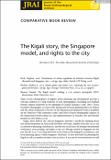| dc.contributor.author | Fischer, Michael MJ | |
| dc.date.accessioned | 2025-10-24T14:58:33Z | |
| dc.date.available | 2025-10-24T14:58:33Z | |
| dc.date.issued | 2025-08-05 | |
| dc.identifier.uri | https://hdl.handle.net/1721.1/163384 | |
| dc.description.abstract | Three recent ethnographies of Kigali's urban planning and development provide a welcome addition to a long tradition of such ethnographies, including Lisa Redfield Peattie's famous fieldwork in the planning of Ciudad Guayana (1968; 1987), Grace Goodell's ethnographic account of the disjunction between planning offices in Tehran and the urban settlements (sharaks) of the Khuzistan Development Project modelled on the Tennessee Vally Authority (1986), and Gökce Günel's ethnographic analysis of the disjunction between plans for, and implementation of, Mazdar City and Mazdar Institute in Abu Dhabi (2019). | en_US |
| dc.language.iso | en | |
| dc.publisher | Wiley | en_US |
| dc.relation.isversionof | https://doi.org/10.1111/1467-9655.14308 | en_US |
| dc.rights | Creative Commons Attribution | en_US |
| dc.rights.uri | https://creativecommons.org/licenses/by/4.0/ | en_US |
| dc.source | Wiley | en_US |
| dc.title | The Kigali story, the Singapore model, and rights to the city | en_US |
| dc.type | Article | en_US |
| dc.identifier.citation | Fischer, M.M.J. (2025), The Kigali story, the Singapore model, and rights to the city. J R Anthropol Inst, 31: 937-949. | en_US |
| dc.contributor.department | Massachusetts Institute of Technology. Department of Anthropology | en_US |
| dc.relation.journal | Journal of the Royal Anthropological Institute | en_US |
| dc.eprint.version | Final published version | en_US |
| dc.type.uri | http://purl.org/eprint/type/JournalArticle | en_US |
| eprint.status | http://purl.org/eprint/status/PeerReviewed | en_US |
| dc.date.updated | 2025-10-24T14:53:16Z | |
| dspace.orderedauthors | Fischer, MMJ | en_US |
| dspace.date.submission | 2025-10-24T14:53:17Z | |
| mit.journal.volume | 31 | en_US |
| mit.journal.issue | 3 | en_US |
| mit.license | PUBLISHER_CC | |
